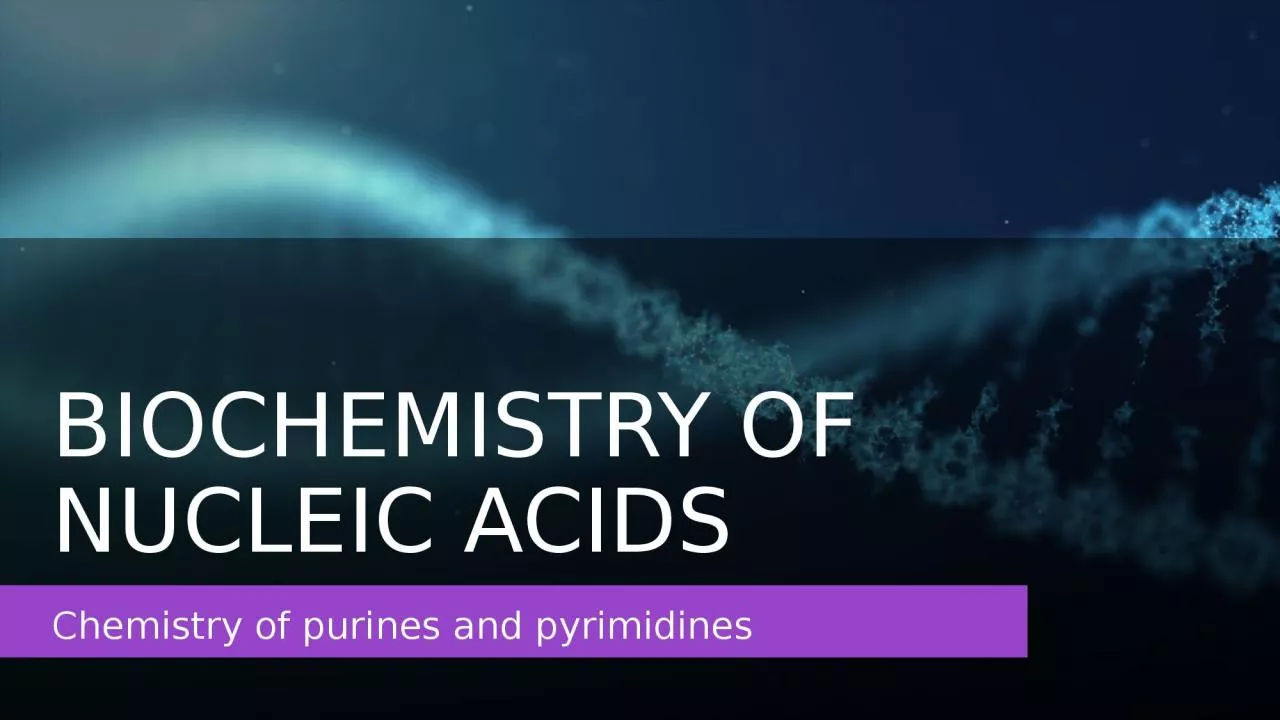

Chemistry of purines and pyrimidines Nucleic Acid Long chains of repeated nucleotides A nucleotide consists of 1 Nitrogenous base 2 Pentose sugar 3 One or more phosphate groups History Nucleotide ID: 918498
Download Presentation The PPT/PDF document "BIOCHEMISTRY OF NUCLEIC ACIDS" is the property of its rightful owner. Permission is granted to download and print the materials on this web site for personal, non-commercial use only, and to display it on your personal computer provided you do not modify the materials and that you retain all copyright notices contained in the materials. By downloading content from our website, you accept the terms of this agreement.
Slide1
BIOCHEMISTRY OF
NUCLEIC ACIDS
Chemistry of purines and pyrimidines
Slide2Nucleic Acid
Long chains of repeated nucleotides
A nucleotide consists of:
1- Nitrogenous base
2- Pentose sugar
3- One or more phosphate groups
Slide3History
Slide4NucleotideContainsNitrogenous BasePentose SugarPhosphoryl group
Slide5Nitrogenous Bases
Aromatic Heterocyclic compounds with Nitrogen atomPurine – Consist of pyrimidine ring fused to an imidazole ring
The atoms of purine ring are numbered in the anticlockwise mannerPyrimidine- Similar to benzene/ pyridine, containing nitrogen at position 1 and 3 of six membered ring Atoms in pyrimidine ring are numbered in clockwise direction
Slide6PurineMajor Purine bases areAdenineGuanine
Slide7PyrimidineCytosineThymineUracil
Slide8Tautomerism of BasesThe group with oxo functional group show tautomerizationPresent as Keto (lactam)Enol (lactim)
Slide9Minor bases in nucleic acids5-methylcytosine, N4-acetylcytosine, N6 methyl adenine, N6 dimethyl adenine & N7 methylguanine, 5-methylcytosine, 5-hydroxymethylcytosine, DihydroxyuracilDue to:
Methylation, Hydroxymethylation, Glycosylation, Alteration of atomsHelp in the recognition of specific enzymes.
Slide10Purine bases of plantsPlants contain certain methylated purines.Caffeine (1,3,7-trimethylxanthine):It is found in coffee.
It acts as a stimulant.Theophylline (1,3-dimethylxanthine):Present in tea leaves.It acts as a bronchial smooth muscle relaxant.
Slide11Special BasesPresent in the free state in the cell
Slide12AnaloguesAllopurinol:Inhibits xanthine oxidase & used in the treatment of hyperuricemia (gout)6-mercaptopurine:It inhibits purine nucleotide synthesis & used as an anticancer drug
5-fluorouracil:It inhibits the enzyme thymidylate synthase.It is used in the treatment of cancer
Slide13Pentose SugarDNA & RNA are distinguished based on the pentose sugar presentDNA contains β-D-2-deoxyribose
RNA contains β-D-riboseAbsence of the 2′ hydroxyl group in deoxyribose is responsible for much greater chemical stability of DNA
The increased flexibility of DNAwhich allows DNA to assume the double-helix conformation
Slide14Nucleoside
Composed of nitrogenous base and Pentose sugar
N-glycosidic bond between nitrogen of base and sugar carbon
Nucleosides with purine bases have the suffix – sine while pyrimidine nucleosides end with - dine
Slide15Nucleotide
Slide16Principal NucleotidesRibonucleotides are named asAdenine = Adenosine monophosphate (AMP)Guanine = Guanosine monophosphate (GMP)Cytosine = Cytidine monophosphate (CMP)Thymine = Thymidine monophosphate (TMP)
Uracil = Uridine monophosphate (UMP)
Deoxyribonucleotides are named asAdenine = Deoxyadenosine monophosphate (dAMP)Guanine = Deoxyguanosine monophosphate (dGMP)Cytosine = Deoxycytidine monophosphate (dCMP)Thymine = Deoxythymidine monophosphate (dTMP)Uracil = Deoxyuridine monophosphate (dUMP)
Slide17Functions of NucleotidesNucleic acid biosynthesis- DNA, RNAEnergy production and transduction - ATPProtein biosynthesis - GTPIntra- and intercellular signal transduction - cAMP Carrier of methyl group in the form
S-adenosyl methionine (SAM)Components of coenzymes: NAD, FAD
Slide18Properties of Nucleotides1. Negative charge at physiological pHMononucleotides have a negative charge at physiological pHNucleosides and or free purine or pyrimidine bases are uncharged at physiological pH
Slide192. UV light absorptionThe conjugated double bonds of the heterocyclic bases of purines and pyrimidines ensure that nucleosides, nucleotides and polynucleotides absorb UVTheir spectra are pH- dependent but all common nucleotides absorb light at a wave length close to 260 nm at pH 7,0Nucleotide and nucleic acid concentrations thus often are expressed in terms of ‘absorbance at 260 nm’
Slide20What absorb where?
Slide213. Incorporated in coenzymesAMP is present in many coenzymes
NAD
+
FAD
CoA
Slide224. High group transfer potentialDue to acid anhydride bondsallows them to participate as group transfer reagents in various reactionscleavage of an acid anhydride bond is coupled with a highly endergonic reaction such as protein synthesis or nucleic acid synthesisADP and ATP are substrates and products, respectively, for oxidative phosphorylation
ATP serves as the major biologic transducer of free energy
Slide23Nucleoside diphosphate kinases, found in all cells, catalyzes the reaction